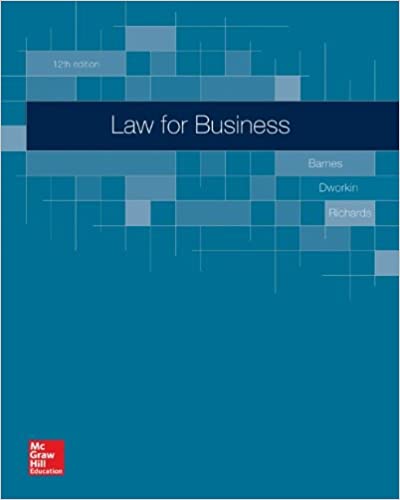
Law for Business 12th Edition by James Barnes,Terry Dworkin,Eric Richards
Edition 12ISBN: 978-0078023811
Law for Business 12th Edition by James Barnes,Terry Dworkin,Eric Richards
Edition 12ISBN: 978-0078023811 Exercise 2
Describe the various ways in which the courts make law.
Explanation
INTRODUCTION:
LAW is a set of rules. It is established by government. Law is for all members of society and members are bind to follow them.
ROLE OF COURT IN LAW MAKING :-
Court is a governmental body. It consists of one or more judges. They preside over a case and provide judgment thereon. There are numerous ways of law making. Judiciary is one of the most important methods. Courts have power to make laws in three ways:
1. By Common law tradition: The court decides a case and resolves dispute. It is also called Judge Made Law. This common law can be termed as: Precedent and stare decisis. The decision of court is precedent and it is binding on all subordinate courts. Stare decisis stands for following the precedents.
2. By Interpreting Statute: The court has power to interpret the law. It explains or clarifies the exact meaning of law and applies it in state.
3. By Judicial review: The court has power to decide the constitutionality of the statute and other governmental body.
The court possesses some law making power of parliament. The development of law by courts shows the united strength of parliament and the judiciary.
LAW is a set of rules. It is established by government. Law is for all members of society and members are bind to follow them.
ROLE OF COURT IN LAW MAKING :-
Court is a governmental body. It consists of one or more judges. They preside over a case and provide judgment thereon. There are numerous ways of law making. Judiciary is one of the most important methods. Courts have power to make laws in three ways:
1. By Common law tradition: The court decides a case and resolves dispute. It is also called Judge Made Law. This common law can be termed as: Precedent and stare decisis. The decision of court is precedent and it is binding on all subordinate courts. Stare decisis stands for following the precedents.
2. By Interpreting Statute: The court has power to interpret the law. It explains or clarifies the exact meaning of law and applies it in state.
3. By Judicial review: The court has power to decide the constitutionality of the statute and other governmental body.
The court possesses some law making power of parliament. The development of law by courts shows the united strength of parliament and the judiciary.
Law for Business 12th Edition by James Barnes,Terry Dworkin,Eric Richards
Why don’t you like this exercise?
Other Minimum 8 character and maximum 255 character
Character 255


